Dorchester to Abingdon
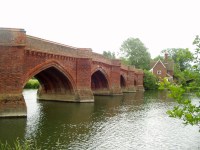
Dorchester to Abingdon |  |
| Upstream: Abingdon to Oxford | Back to Main Page | Downstream: Cholsey to Dorchester |
Introduction
This walk starts in historic town of Dorchester, with it's abbey, rejoining the Thames and continuing over the beautiful Clifton Hampden Bridge to the north bank of the Thames. This part of the path is very rural in character, passing the villages of Burcot, Clifton Hampden, Appleford and Culham, mostly on the opposite banks of the river, and two navigable cuts to the river at Clifton and Culham before arriving in the busy market town of Abingdon.
Getting to the Start
Dorchester is just off the A4074 a few miles to the north of Wallingford and a few to the east of Abingdon. From the M40, exit at junction 7 and join the A329 to the south. At the junction with the A4074 turn right onto the A4074 then take the road on the left signed to Dorchester. Parking is available in the town centre. From the A34 exit onto the A415 to the east through Abingdon and turn right just after passing Burcot into Dorchester.
By public transport, Thames Travel bus service 139 links Dorchester with Abingdon, Culham, Shillingford and Wallingford and runs approximately hourly, Monday - Saturday. Thames Travel service 105 serves nearby Shillingford and Berinsfield and runs from Oxford to Cholsey, and there are railway stations at both Oxford and Cholsey if you're travelling from further afield. Ask the driver when boarding, as this bus may also stop at the lay-by on the A4074 near Dorchester.
The Walk
Dorchester is a beautiful town, well worth spending some time in. with it's Abbey dating from 1140. The High Street also has several pretty cottages and historic Inns.
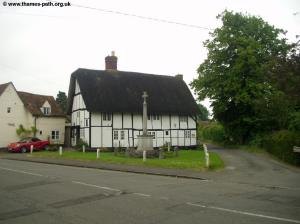 |
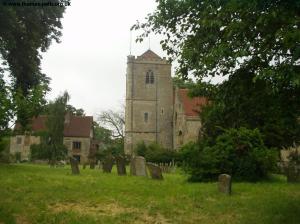 |
| Dorchester | Dorchester Abbey |
To return to the Thames from Dorchester, head down the High Street and turn right into Bridge End as the main road starts to climb away from the town, entering the village of Bridge End. When you get a choice of routes, turn slightly right down then immediately left down Whitenham Lane. At the end of this road you'll find the footpath back to the Thames. On this path you'll pass the Dyke Hills, the early defences of the town.
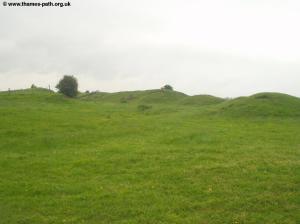 |
| The Dyke Hills |
When there is a path to the right continue straight on to rejoin the banks of the Thames, where you turn right. On the opposite bank of the river you can see Castle Hill and soon the Thames turns to the right, where there is a bridge into the village of Little Wittenham, however the Thames Path continues on this bank for a little further to Day's Lock ahead, where you first cross the lock and then the weir to rejoin the south bank of the Thames.
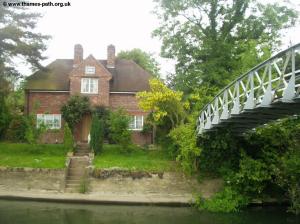 |
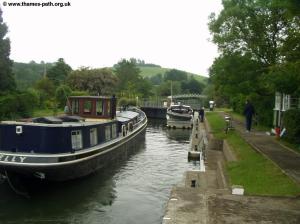 |
| Day's Lock | Day's Lock |
Beyond the lock the next couple of miles are through beautiful unspoilt countryside. To your right you can see the tower of Dorchester Abbey to the right whilst to your left there are open fields, though sadly the view is blighted somewhat by the enormous cooling towers and chimneys of Didcot Power Station in the distance. Soon the Thames starts to curve round to the left a little and soon the well-kept gardens of the houses of Burcot line the north bank of the river.
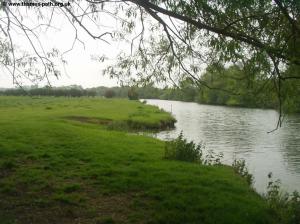 |
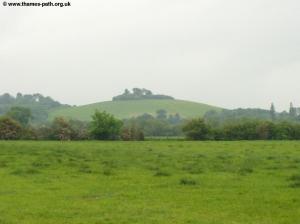 |
| The Thames between Little Wittenham and Burcot | Looking back to Castle Hill |
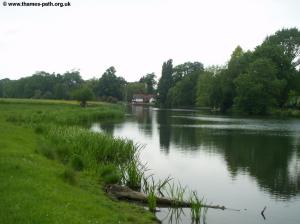 |
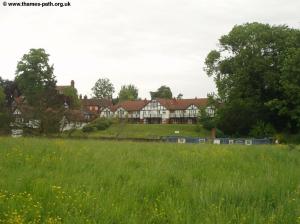 |
| The Thames near Burcot | Burcot |
Soon you see the beautiful red brick bridge of Clifton Hampden ahead, with the spire of the church visible through the trees to the right. The village itself is equally beautiful, with many thatched cottages, the church and the Barley Mow pub, making this one of the prettiest scenes on the Thames.
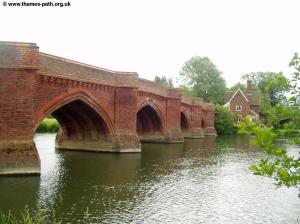 |
| Clifton Hampden Bridge |
The Thames Path crosses the bridge at Clifton Hampden, another narrow bridge with the traffic controlled by traffic lights, giving welcome gaps between the cars. Once across the bridge, the path continues on the other side, towards Clifton Lock and Weir. Here the Thames Path leaves the course of the river behind and briefly follows the man-made Clifton Cut, now the navigable part of the river at the weir. Ahead you can see the church of Long Wittenham, with the modern towers of Didcot Power Station behind.
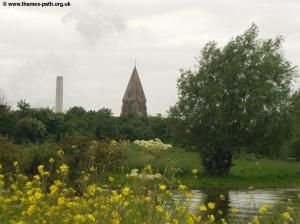 |
| Long Wittenham Church, with the more modern towers of Didcot Power Station behind |
Soon you see the larger weir where the river re-joins the man-made cut once more. Ahead you soon see the somewhat ugly Appleford Railway bridge, carrying the railway line between Didcot and Oxford.
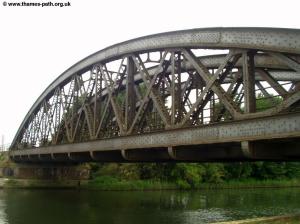 |
| Appleford Bridge |
The Thames is peaceful again beyond the railway bridge, though the towers of Didcot Station are still visible to the left, and soon you pass under one of the many power cables radiating from the power station.
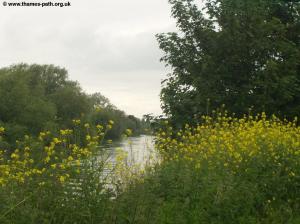 |
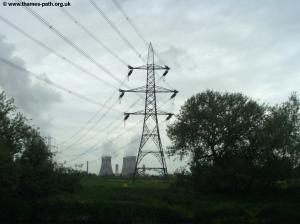 |
| The Thames near Appleford | The power lines from Didcot Power Station |
Soon the narrow Sutton Bridge can be seen ahead, marking the edge of Culham to the right of the river. The three arched bridge crosses the Thames, whilst a single arch is available to Culham Lock, where another cut has been made. The Thames Path follows this cut, whilst the original course of the river is through Sutton Courtenay village to the south.
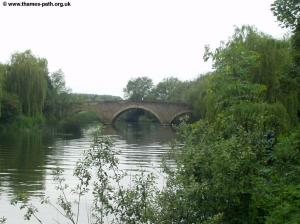 |
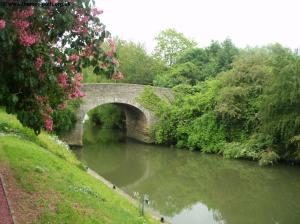 |
| Sutton Bridge | The bridge by the cut to Culham Lock |
As you go over the bridge you come to Culham Lock, similar to many along the Thames.
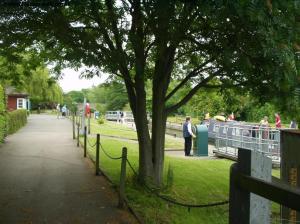 |
| Culham Lock |
Beyond the lock the path continues next to the cut, with Culham Manor and the village to the right. There is a footbridge to the left which takes you across the river to the village of Sutton Courtenay where once again you can see the towers of the power station beyond. As the path turns to the right it rejoins the original course of the Thames north to Abingdon, past open fields once more. Soon to the right you can see Culham Bridge, going over a river marked as Back Water on the map. Shortly after this there is an entrance to a mariner on the left and this mariner marks the outskirts of Abingdon across the river.
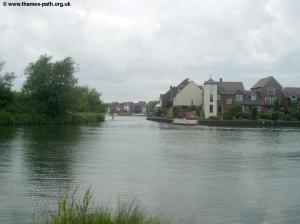 |
| Abingdon Marina |
Beyond the Marina is a development of modern houses. I didn't know much about Abingdon and was wondering if I was heading into a fairly modern and bland town, but in fact Abingdon is a beautiful and historic town and the frontage to the river greatly improves as the Thames gets closer to the town centre. Particularly attractive is the church to the left as Abingdon Bridge approaches, one of the more elegant bridges on the Thames. To the right there was a game of Cricket going on, making me suspect this was a scene that hasn't changed for many years. It was also a pleasant surprise (especially for boat owners) to find the moorings are all free along the banks by the town centre.
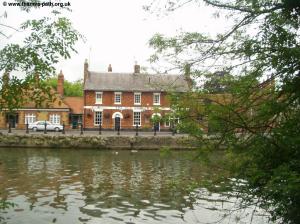 |
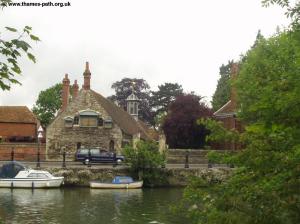 |
| Abingdon | Abingdon |
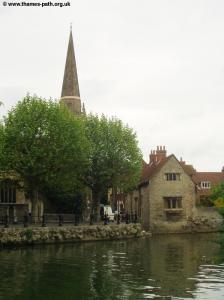 |
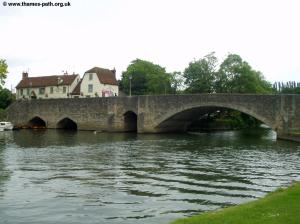 |
| Abingdon | Abingdon Bridge |
The Thames path continues on the same bank beyond Abingdon, but from the bridge you can turn left into the historic town centre.
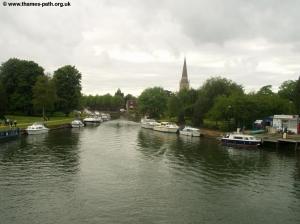 |
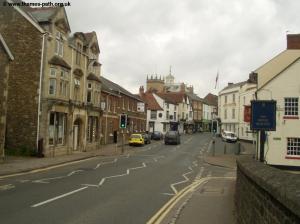 |
| The Thames from Abingdon Bridge | Abingdon |
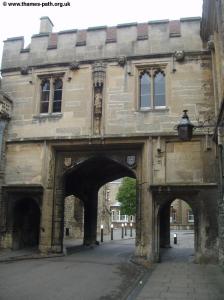 |
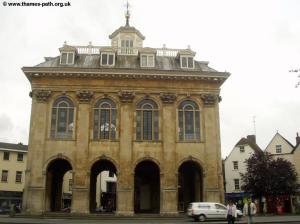 |
| Abingdon | Abingdon |
Getting Back
Abingdon doesn't have a station, but it does have excellent bus services. If you're returning to Dorchester, Thames Travel service 139 operates hourly (Monday - Saturday) from Abingdon to Dorchester. If you're travelling further afield there is a very frequent service to Oxford, Oxford Bus service X3, using modern air-conditioned buses and running every 10 minutes during the daytime Monday - Saturday and every 20 minutes on Sunday. These buses also serve Oxford Station which has frequent trains to London, Leamington, Birmingham, Reading as well as many local services. Stagecoach Oxford service X4 also operates every 10 minutes during the day on Mondays - Saturday and every hour on Sundays to Oxford.
If you're heading south or west, buses also operate frequently from Abingdon to Didcot Parkway Station, which has frequent trains to Swindon, Bristol, Reading, Slough, Oxford and London, as well as local services. Stagecoach Oxford service 32 runs hourly from Abingdon to Culham, Milton, Didcot (and Didcot Parkway station), Harwell, Wantage (with some services continuing to Grove). Oxford Bus service 35A runs every 30 minutes from Abingdon to Didcot Parkway station, Monday - Saturday whilst services 35 and 35A operate every 15 minutes (Monday - Saturday) to Radley Station and also every 30 minutes on Sundays. A large number of services to other local towns and villages are also available - see the links below for more information.
Links
The following web sites provide information on the area.
Every effort is made to ensure the accuracy of information on this site, but liability will not be assumed in the event of any inaccuracies. Use of the information on this site is at your own risk. If you find any errors, please use the link below. The text and photographs on this web site are all Copyright © and may not be reproduced without prior permission